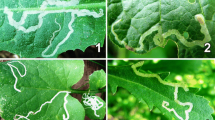Abstract
The life cycle of the moth,Meskea horor Dyar and its host specificity toSida acuta andS. rhombifolia were investigated. Moths emerge early in the morning and are usually inactive during the day. Feeding by the adults in the field was not observed. However, those in the laboratory fed on flowers ofS. acuta, S. rhombifolia andHibiscus sabdariffa, and drank water or dilute honey solution. Eggs are mainly laid on the underside of leaves. Larvae ofM. horor form galls in the stems ofS. acuta andS. rhombifolia which retard plant growth and flowering. Pupation occurs within the gall. The development time from egg to adult was 192 days and the adults lived for 11 to 14 days. Forty-eight plant species were tested to determine the host range ofM. horor. Adults emerged from seven species of plants in the family Malvaceae and larvae formed galls but died before pupating on a further 17 species.M. horor is considered to have too broad a host range to be used as a biological control agent forS. acuta andS. rhombifolia.
Résumé
Le cycle de développement deMeskea horor Dyar et sa spécificité vis-à-vis des hôtes,Sida acuta etS. rhombifolia ont été étudiés. Les lépidoptères émergent tôt le matin et sont généralement inactifs pendant la journée. Si l’alimentation des adultes n’a jamais été observée dans la nature, en laboratoire par contre, ces insectes se nourrissent de fleurs deS. acuta, S. rhombifolia etHibiscus sabdariffa et boivent de l’eau ou une solution diluée de miel. Les oeufs sont pondus principalement sur la surface inférieure des feuilles. Les larves deM. horor forment des galles à l’intérieur des tiges deS. acuta, ce qui retarde la croissance et la floraison de la plante. La nymphose a lieu dans la galle. La durée de développement, de l’oeuf à l’adulte, est de 192 jours et les adultes vivent entre 11 et 14 jours. Quarante-huit espèces de plantes ont été testées pour déterminer la gamme d’hôtes deM. horor. Les adultes émergent de 7 espèces de plantes appartenant à la famille des Malvacées et les larves forment des galles mais meurent avant nymphose dans 17 autres espèces. En conséquence,M. horor ayant une gamme d’hôtes trop étendue ne peut être utilisé comme agent de lutte biologique contreS. acuta etS. rhombifolia.
Similar content being viewed by others
References
Comite de Control Integrado de Plagas del Algodonero. — 1976. Guia de control integrado de plagas del Algodonero. —Algodonero, 5 (20), 3–43.
Cruttwell, R. E. — 1977. Insects and mites attackingEupatorium odoratum L. in the neotropics. 5.Mescinia sp. nr. parvula (Zeller). —Tech. Bull. No. 18, CIBC, 49–58.
Cullen, J. M. — 1989. Current problems in host specificity screening. In: Proceedings of the International Symposium on Biological Control of Weeds, Rome, Italy, 1988 (E.S. Delfosse, ed.),Instituto Sperimentale per la Patologia Vegetale Ministero dell ’Agricoltura e delle Foreste, Rome, 27–36.
Dyar, H. G. — 1913. New Lepidoptera from Mexico. —Proc. U.S. Nat. Mus., 44, 317.
Forno, I. W., Kassulke, R. C. &Day, M. D. — 1991. Life cycle and host testing procedures forCarmenta mimosa Eichlin and Passoa (Lepidoptera: Sesiidae), a biological control agent forMimosa pigra L. (Mimosaceae) in Australia. —Biol. Contr. 1, 309–315.
Forno, I. W., Kassulke, R. C. &Harley, K. L. S. — 1992. Host specificity and aspects of the biology ofCalligrapha pantherina (Col.: Chrysomelidae), a biological control agent ofSida acuta (Malvaceae) andS. rhombifolia in Australia. —Entomophaga, 37, 409–417.
Gillet, J. D., Harley, K. L. S., Kassulke, R. C. &Miranda, H. J. — 1991. Natural enemies ofSida acuta andS. rhombifolia (Malvaceae) in Mexico and their potential for biological control of these weeds in Australia. —Environ. Entomol., 20, 882–888.
Holm, L. G., Pluckett, D. L., Pancho, J. V. &Herberger, J. P. — 1977. The worlds worst weeds: Distribution and biology. —The University of Hawaii, Honolulu, 621.
Kleinschmidt, H. E. & Johnson, R. W. — 1977. Weeds of Queensland. —Queensland Department of Industries, 469.
McClay, A. S. — 1987. Observations on the biology and host specificity ofEpiblema strenuana (Lepidoptera, Tortricidae), a potential biocontrol agent forParthenium hysterophorus (Compositae). —Entomophaga, 32, 23–34.
Parsons W. T. &Cuthbertson, E. G. — 1992. Noxious Weeds of Australia. —Inkata Press, Melbourne, 508–510.
Sturtz, J. D., Harrison, P. G. &Falvey, L. — 1975. Regional pasture development and associated problems. II Northern Territory. —Tropical Grasslands, 9, 83–91.
Wapshere, A. J. — 1989. A testing sequence for reducing rejection of potential biological agents for weeds. —Ann. Appl. Biol., 114, 515–526.
Author information
Authors and Affiliations
Rights and permissions
About this article
Cite this article
Day, M.D., Segura, R. & Martinez, M. Life cycle and host range of the gall-forming moth,Meskea horor (Lep.: Thyrididae), and its suitability as a biological control agent forSida acuta andS. rhombifolia (Malvaceae). BioControl 42, 393–403 (1997). https://doi.org/10.1007/BF02769833
Received:
Accepted:
Published:
Issue Date:
DOI: https://doi.org/10.1007/BF02769833



